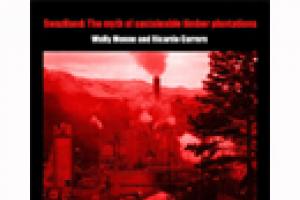By Wally Menne and Ricardo Carrere
Swaziland
Other information
2 July 2006
About 9% of Swaziland is now under timber plantations (eucalyptus, pine and acacia). In December 2004 Wally Menne, a member of the South African Timberwatch Coalition made public his research: “Timber Plantations in Swaziland: An investigation into the environmental and social impacts of large-scale timber plantations in Swaziland” (available at http://www.wrm.org.uy/countries/Swaziland/Plantations.pdf ).
Bulletin articles
26 January 2005
Looking at the statistics for Swaziland is a depressing experience. Unemployment stands at 40 per cent. More than two-thirds of the people in Swaziland live on an income of less than US$1 a day. About one third of the people in Swaziland rely on food aid to survive. Nearly 40 per cent of the population is infected with HIV - one of the highest rates in the world. Life expectancy has fallen to 33 years for men and 35 for women.
Bulletin articles
3 May 2004
In many respects, there is very little difference between Swaziland and South Africa. Climate, topography, and geology are similar, so it is no wonder that the natural vegetation is much like that found in the South African Provinces of KwaZulu-Natal and Mpumalanga, that virtually enclose the Swazi Kingdom.
Bulletin articles
11 March 2004
Swaziland, a landlocked country with a population of 1,161,219 inhabitants in 17,363 sq km almost completely surrounded by South Africa, has timber as its second industrial activity after sugar.
During the Conference “Timber Plantations: Impacts, Future Visions and Global Trends” held in Nelspruit, South Africa, in November 2003, hosted by GeaSphere in association with the TimberWatch Coalition, Nhlanhla Msweli, from SCAPEI, gave a vivid testimony of Swaziland’s situation and grief linked to monoculture tree plantations.
Bulletin articles
3 May 2003
Residents south of the Matsapha Industrial Estate, where the nation's manufacturing sector is based, recently complained of ailments resulting from the consumption of "poison" water from the Lusushwana river. The river is clean when it flows out of Mantenga Nature Reserve, but then it passes through the Matsapha industries where its colour changes, according to residents who depend on the river for their water needs. "It is brown one day, grey the next," said Thab'sile Dlamini, who lives in an informal settlement that has sprung up along the riverbank.

